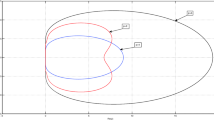Abstract
Stability analysis of Runge-Kutta (RK) formulas was originally limited to linear ordinary differential equations (ODEs). More recently such analysis has been extended to include the behaviour of solutions to nonlinear problems. This extension led to additional stability requirements for RK methods. Although the class of problems has been widened, the analysis is still restricted to a fixed stepsize. In the case of differential algebraic equations (DAEs), additional order conditions must be satisfied [6] to achieve full classical ODE order and avoid possible “order reduction”. In this case too, a fixed stepsize analysis is employed. Such analysis may be of only limited use in quantifying the effectiveness of adaptive methods on stiff problems.
In this paper we examine the phenomenon of “order reduction” and its implications on variable-step algorithms. We introduce a global measure of order referred to here as the “observed order” which is based on the average stepsize over the region of integration. This measure may be better suited to the study of stiff systems, where the stepsize selection algorithm will vary the stepsize considerably over the interval of integration. Observed order gives a better indication of the relationship between accuracy and cost. Using this measure, the “observed order reduction” will be seen to be less severe than that predicated by fixed stepsize order analysis.
Similar content being viewed by others
References
C. Mac Donald, The practical implications of order reduction on the solution of stiff intial value problems using Runge-Kutta formulas, Master's Thesis, Department of Computer Science University of Toronto (1990).
K. Burrage and L. Petzold, On order reduction for Runge-Kutta methods applied to differential/algebraic stiff systems of ODES, SIAM J. Numer. Anal. 27 (1990) 447–456.
E. Hairer, C. Lubish and M. Roche,The Numerical Solution of Differential-Algebraic Systems by Runge-Kutta Methods, Lecture Notes in Mathematics 1409 (1989).
R.C. Aiken (ed.),Stiff Computation (Oxford University Press, 1985) pp. 1–8 and 16–21.
R. Alexander, Diagonally implicit Runge-Kutta methods for stiff O.D.E.'s, SIAM J. Numer. Anal. 14 (1977) 1016–1021.
K.E. Brenan and L.R. Petzold, The numerical solution of higher index differential/algebraic equations by implicit Runge-Kutta methods, SIAM J. Numer. Anal. 23 (1986) 837–852.
K. Burrage, Implementable algebraically stable Runge-Kutta methods,SIAM J. Numer. Anal. 19 (1982) 245–258.
J.C. Butcher,The Numerical Analysis of Ordinary Differential Equations (Wiley, 1987) pp. 114–117, 228, 237–270.
G. Dahlquist, A special stability problem for linear multistep methods, BIT 3 (1963) 27–43.
C.W. Gear,Numerical Initial Value Problems in Ordinary Differential Equations (Prentice-Hall, 1971) pp. 1–44, 209–212.
E. Hairer, S.P. Norsett and G. Wanner,Solving Ordinary Differential Equations, Vol. 1: Non Stiff Problems (Springer, 1987) pp. 130–140.
K. Dekker and J.G. Verwer,Stability of Runge-Kutta Methods for Stiff Nonlinear Differential Equations (North-Holland, Amsterdam, 1984) pp. 195–218.
S.L. Campbell, K.E. Brenan and L.R. Petzold,Numerical Solution of Initial Value Problems in Differential/Algebraic Equations by Implicit Runge-Kutta Methods (North-Holland, 1989) pp. 75–108.
F.T. Krogh, On testing a subroutine for the numerical integration of ordinary differential equations, J. ACM 20 (1973) 545–562.
A. Prothero and A. Robinson, On the stability and accuracy of one-step methods for solving stiff systems of ordinary differential equations, Math. Comput. 28 (1974) 145–162.
J. Schneid, R. Frank and C.W. Ueberhuber, Order results for implicit Runge-Kutta methods applied to stiff systems, SIAM J. Numer. Anal. 22 (1985) 515–534.
B.W. Char, K.O. Gettes, G.H. Gonnet, M.B. Monagan and S.M. Watt, Maple Reference Manual, Symbolic Computation Group (1988).
H.J. Stetter,Analysis of Discretization Methods for Ordinary Differential Equations (Springer, 1973) pp. 121–131.
Author information
Authors and Affiliations
Additional information
Communicated by Å. Björck
Supported by the Information Technology Research Centre of Ontario, and the Natural Science and Engineering Research Council of Canada.
Rights and permissions
About this article
Cite this article
Donald, C.M., Enright, W.H. Implications of order reduction for implicit Runge-Kutta methods. Numer Algor 2, 351–369 (1992). https://doi.org/10.1007/BF02139474
Received:
Published:
Issue Date:
DOI: https://doi.org/10.1007/BF02139474




